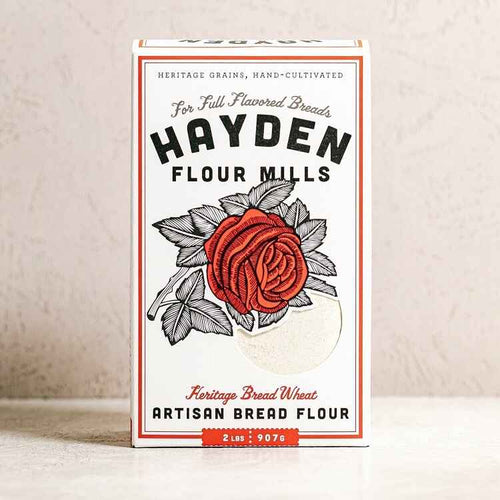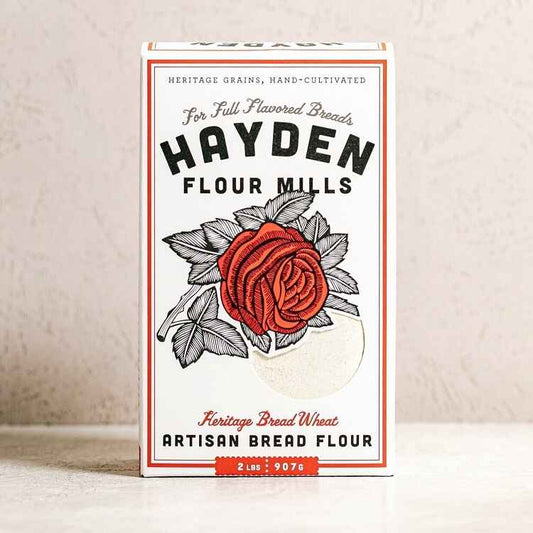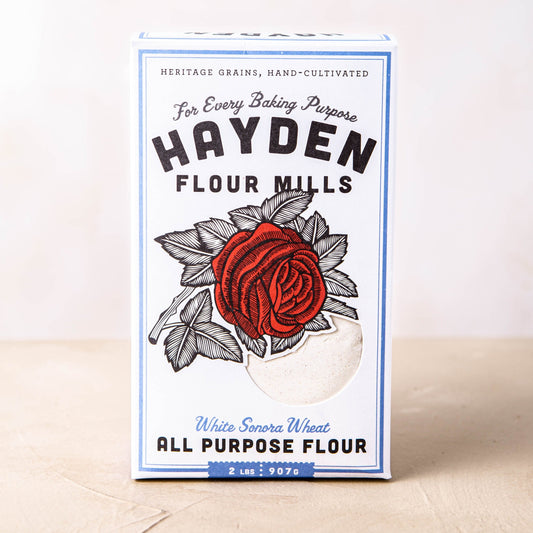What You'll Need
Tools
Kitchen scale
Mixing Bowl
Dough Scraper
Tea Towel
2 Proofing Baskets (Oval or Round)
Parchment Paper
5-quart (or larger) Dutch oven (1 or 2)
Levain
35 grams reserved starter
80 grams Artisan Bread Flour
30 grams Whole Rye Flour
105 grams warm filtered water
Autolyse
1,000 grams Artisan Bread Flour
620 grams warm water
Slurry
60 grams real maple syrup
30 grams salt
250 grams active starter (levain)
30 grams warm water
Directions
Desired dough temperature: 78°F (25°C)
Prepare the levain (8am)
To make the levain, mix the levain ingredients in a jar and leave them covered at a warm temperature, 74-76°F, to ripen for 5 hours.
Autolyse (12pm)
Warm or cool the autolyse water so that the temperature of the mixed dough meets the FDT (final dough temperature) of 78°F (25°C) for this recipe.
Place the autolyse ingredients in a bowl and mix by hand. Use dough whisk or wet hands to mix until no dry bits remain. The dough will be shaggy and loose.
Use a bowl scraper to scrape down the sides of the bowl to keep all the dough in one area at the bottom. Cover the bowl and place it near your levain for about an hour.
Mix Dough (1:00pm)
In a small bowl, thoroughly mix together the slurry ingredients. Add slurry to the dough that was just in autolyse and use a splash of water to moisten. With wet hands, mix thoroughly. Next, knead the dough for about 5 minutes until the dough becomes smooth and elastic.
Transfer the dough to a bulk fermentation container and cover.
Bulk Fermentation (1:15pm-4:15pm)
At a warm room temperature, 74-76°F (23-24°C), bulk fermentation should take about 3 hours.
This dough will require 4 sets of stretches and folds during bulk fermentation. After the first 30 minutes, wet your hands, grab one side of the dough, and lift it up and over to the other side. Rotate the bowl 180 degrees and repeat. Then rotate the bowl a quarter turn and stretch and fold that side. Rotate the bowl 180 degrees again and finish with a stretch and fold on the last side. The dough should be neatly folded up in the bowl.
Cover and repeat these folds 3 more times, at 30 minute intervals.
Then let the dough rest, covered, for the remainder of bulk fermentation.
Divide and preshape (4:15pm)
After 3 hours, the dough should be well-risen in the bulk fermentation container and puffy to the touch.
Scrape the dough onto a clean counter. Divide the dough into 2 equal pieces and pre-shape the pieces into loose rounds.
Let the dough rest, uncovered, for 30 minutes.
Shape (4:45m)
Flour the top of the preshaped rounds and your work surface.
Using your bench knife, flip one of the rounds over onto the floured area.
Using floured hands, shape the dough into a round or oval loaf.
Gently transfer loaf into a well-floured proofing basket, seam-side up, cover with a floured tea towel.
Repeat with the remaining dough.
Final Proofing (5:00pm-6:00pm)
Set covered dough baskets in a warm spot in the kitchen for one hour to proof.
Cold Fermentation (6:00pm-8:00am)
Placed covered dough baskets in refrigerator overnight.
Bake (8am-9:30am)
Place an oven rack in the bottom-third of the oven.
Place Dutch oven on middle rack of oven and preheat your oven to 500 F for 30 minutes.
When the oven is preheated, take one of the proofing baskets out of the fridge, uncover it, and put a piece of parchment paper over the basket. Using both hands, flip everything over. Gently remove the basket and score the dough, then transfer to the preheated Dutch oven.
Reduce over temperature to 450 F. Place in the oven, cover with the lid, and bake for 25 minutes. After this time, remove the lid (you can keep it in the oven or remove it) and continue to bake for 30-40 minutes more. When done, the loaf should have an internal temperature of around 204°F (95°C), with an even golden crust. Let the loaves cool on a wire rack for at least 2 hours before slicing.
Repeat for the second loaf.
Makes 2 loaves.
*Recipe contributed by A Sourdough Story *








